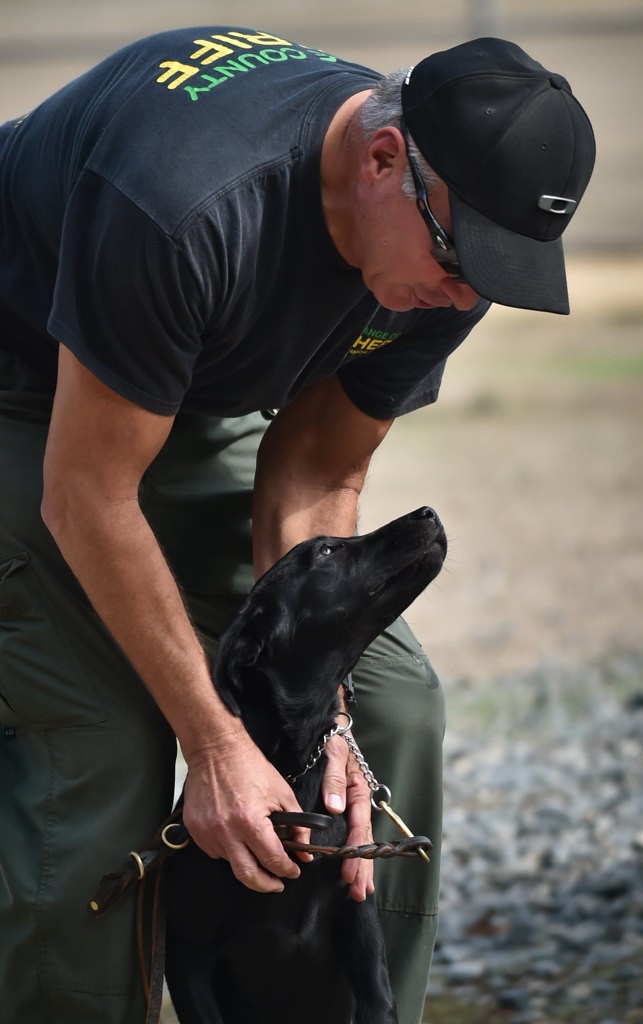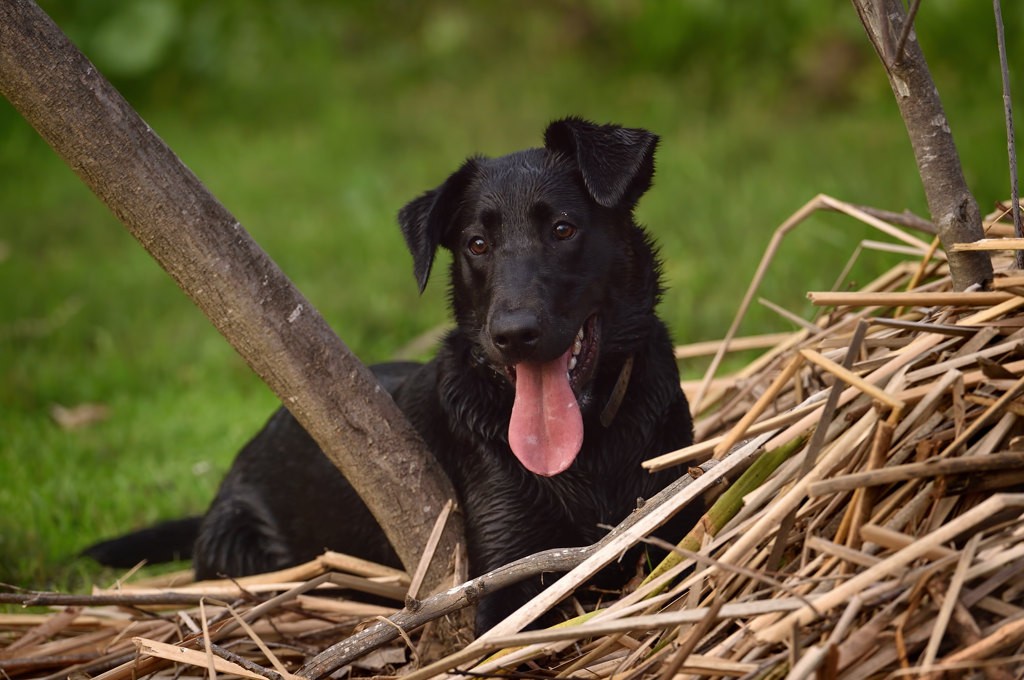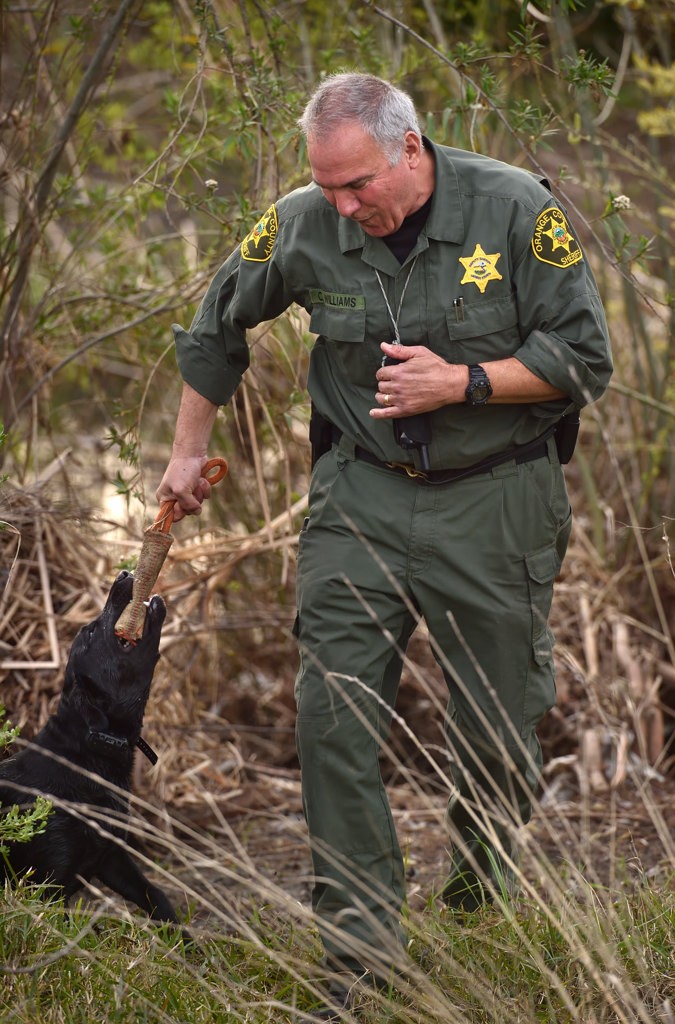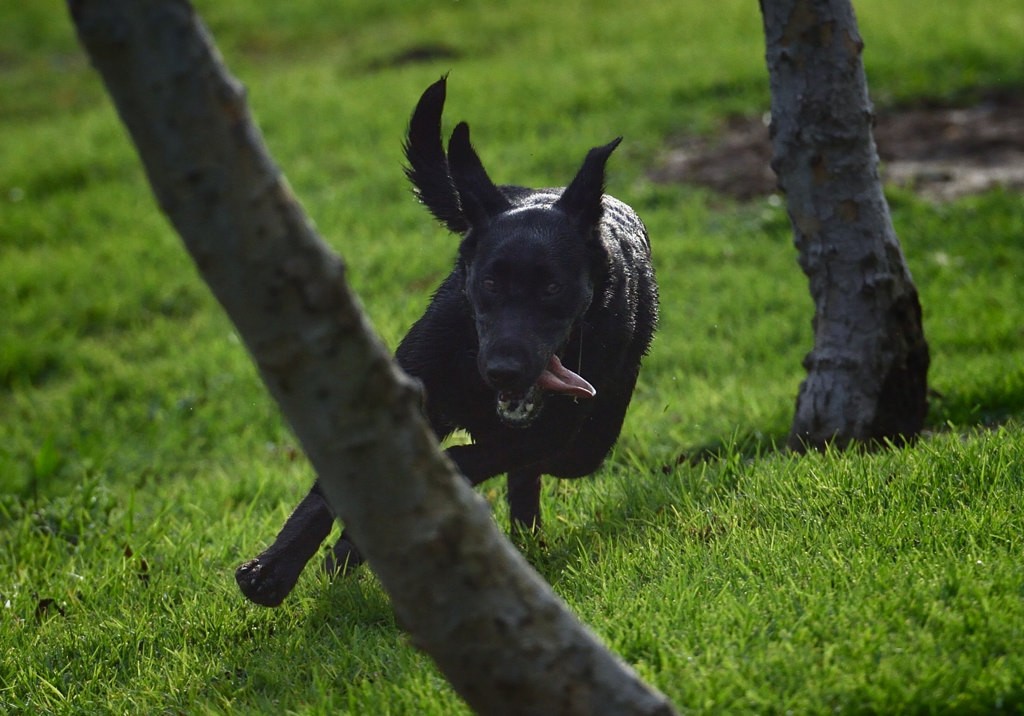In leaps and bounds, Cinder charges through the grassy slopes at Laguna Niguel Regional Park. She stops to chase off a gaggle of geese, and suddenly realizes rolling around in fresh mud seems like a grand idea.
Though the rambunctious 7-month-old black Labrador retriever may not seem like a working dog to a casual passerby – in fact, she is.
And while her nose occasionally redirects to sniff out a nearby dog or other distraction, her handler, Orange County Sheriff’s Department Search and Rescue Reserve Capt. Chuck Williams, quickly redirects her with a command and she’s back on track to find her mark.
Her target? Mainly, some form of scent related to human remains – bloody bandages, human bones, etc. – anything that will help prepare her nose for her intended future career as an OCSD cadaver dog.
“When she starts searching, she’s just a bat out of hell,” says Williams.

OCSD Reserve Capt. Chuck Williams with Cinder, a human remains detection K9, at Laguna Niguel Regional Park.
Photo by Steven Georges/Behind the Badge OC
Cinder’s training began a few months back, with her first exposure to the scent of human decomposition in late October. Her reaction?
A little hesitant at first, but with Williams at her side encouraging her, she soon became curious and moved toward the scent – a great result.
“The majority of dogs, their natural inclination is to go away from that odor,” says Williams.
To help these dogs overcome their instinct, handlers must turn the experience positive.
“We throw a party, we get excited,” he says.
Most dogs become certified at around 18 to 24 months as cadaver dogs, though Williams’ previous dog, yellow Lab retriever Charlee, was certified at 14 months and went on to make eight human remains detection finds – the most of any dog in the western United States at that time – over her 9 1/2-year career.
Sadly, Charlee died of cancer in December 2015.
“It hit me very, very hard,” Williams says.
Now with the highly energetic Cinder ready to learn, Williams is taking his experience training Charlee to help the puppy along.

Reserve Capt. Chuck Williams with Cinder, a human remains detection K9.
Photo by Steven Georges/Behind the Badge OC
Early in November, he began scent box work with four boxes he built about 10 years ago when first starting to train Charlee. Since then, he’s amassed an extensive selection of scent aids to help with this kind of training.
Every morning at sun-up, the pair would head to the front yard (because the backyard is for play) for 15 to 25 minutes of scent-box training. The training involves placing a scent aid in one of the boxes (the “hot box”) and having the dog find the particular scent. Williams would switch out the scents and move the boxes into various configurations, including a square and triangle.
Cinder eventually started working closed-in area searches – from a 10-by-10-foot space where a scent was buried to a one-acre area. She learned to find the target scent using the “scent cone” – the scent typically radiates out of the ground in the shape of an ice cream cone due to the impact of the wind.
“The dogs have an incredible ability to pinging close to the edge of that cone,” Williams says.
While narcotics dogs often scratch or paw, according to Williams, cadaver dogs are typically taught to passively alert by sitting or laying down and placing their nose at the source of the scent. Cinder has learned this passive alert, and lays down when she finds her target.
Cinder’s reward for her efforts started out in the form of food and treats – though now it is a spirited game of tug-of-war with a jute toy and Williams.

Cinder, a human remains detection K9 for the OCSD, sits and waits for Capt. Chuck Williams after locating the target during a training exercise at Laguna Niguel Regional Park.
Photo by Steven Georges/Behind the Badge OC
The scents range from soil found underneath a decomposing body to fresh bloody bandages donated by a physician’s office to human bones (from various medical schools). He has training aids that are up to 10 years old – and can easily be reactivated with water.
“It’s all decomposition related,” says Williams. “It’s your own little detective novel that you’re exploring.”
This is training that will never really end for a cadaver dog. Even after she’s certified through the Office of Emergency Services as a cadaver dog, Cinder will continue searching for new scents.
Cinder’s current training consists of three days of scent work at Laguna Niguel Regional Park, two days at other area parks and even “blind trials” at other police agencies – meaning Williams won’t know where the targets are placed, so it’ll more accurately resemble a search and rescue situation.
At her recent training in Laguna Niguel, the 55-pound Cinder demonstrated a high level of energy, but also a very keen nose. She followed the scent cone back and forth to narrow her search until she found every single target – even the same one several times, in hopes of getting extra rewards. Faced with many distractions at the park, she is learning to focus her attention to the task at hand. And it’s Williams’ job to help her along.

OCSD Reserve Capt. Chuck Williams rewards Cinder with a chew toy after locating the target during a training exercise at Laguna Niguel Regional Park.
Photo by Steven Georges/Behind the Badge OC
“This dog is just off the charts, energy-wise,” Williams says.
Self-control is another aspect of Cinder’s training. So when Cinder is not searching, Williams throws a tennis ball for her to bring back, commanding her for an “emergency stop” in mid-run. It’s an important command for her to learn to protect her in real-life search and rescue work in case Williams needs her to stop suddenly. She also wears an electronic collar with which Williams can “tap” Cinder from a distance to get her attention and also activate a tone to initiate her recall, or have her return immediately.
“I think that high energy is just going to turn into an amazing hunting dog,” he says. “She’s just a hard charger.”
 Behind the Badge
Behind the Badge




